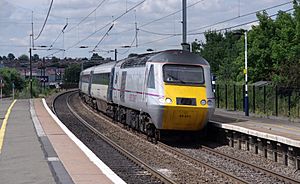East Coast (train company) facts for kids
East Coast was a special train company in Britain. It was owned by the government, which means it was run by the country, not a private business. East Coast ran fast passenger trains on an important railway line called the East Coast Main Line. These trains connected big cities like London, places in Yorkshire, the North East of England, and even went all the way to Scotland.
East Coast started running trains on 14 November 2009. It took over after another company, National Express East Coast, had problems with its agreement to run the trains. East Coast operated until 28 February 2015. During its time, the company used 45 trains and served 53 different train stations. It was directly in charge of running 12 of these stations.
Even though East Coast made a lot of money for the government, its agreement to run the trains eventually ended. The government then gave the job to a new company called Virgin Trains East Coast. This meant the trains were no longer run by the government.
How East Coast Made Money
East Coast was quite successful at making money for the government. Over the years it operated, the company paid back more than £1 billion to the government. This money went into the Treasury, which is like the government's bank account. This was a lot of money, more than double what another company, Virgin Trains, paid back from running trains on the West Coast Main Line during the same time.
Why East Coast Was Profitable
One reason East Coast was able to pay back so much money was because it used older trains. Older trains are usually cheaper to rent or "lease" than brand new ones. For example, in 2012 and 2013, East Coast paid about £53 million to lease its trains. In comparison, Virgin Trains paid a lot more, around £302 million, for its newer trains. This difference in costs helped East Coast contribute more to the government.
What Happened Next
After East Coast, the new company, Virgin Trains East Coast, agreed to pay even more money back to the government. They promised to pay about £3.3 billion over eight years. This was much more than the £1 billion East Coast had paid.


